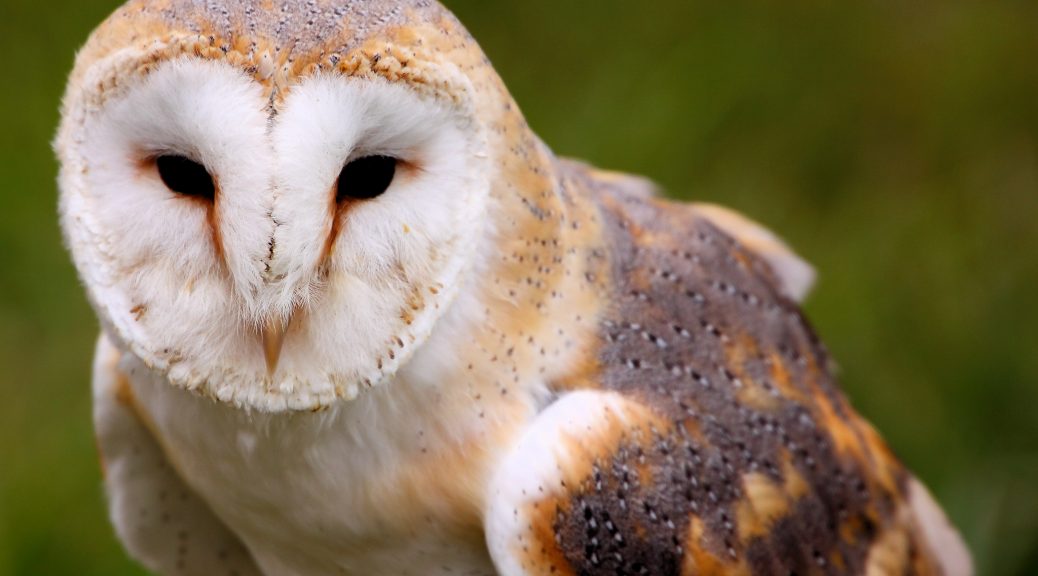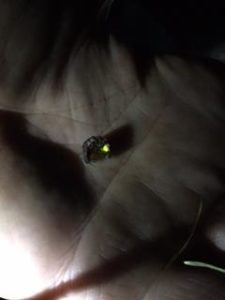CHRISTMAS PARTY – December 2018
A fabulous evening was had – read more about it here. And try out the leaf quiz!
BRITISH OWLS – November 2018
We heard all about owls from Marina Harkins of Merrist Wood. She explained the distribution, favoured habitats, feeding and nesting behaviour of all five British species. There was a word of warning too. The starring role of owls in the Harry Potter films has encouraged some people to want one as a pet. This is completely wrong for a multitude of reasons; owls are wild animals, they are precisely adapted to their environment – they need to fly, to hunt their prey and to live their complex lives. They cannot be happy as a pet and should not be kept as one.
Photo above by Airwolfhound by creative commons: https://creativecommons.org/licenses/by-nc-nd/2.0/legalcode
RETURN OF THE GOSHAWK – October 2018
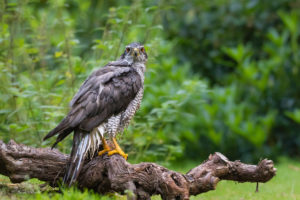
Our speaker on the return of the goshawk to the UK was Dave Burgess, a bird enthusiast who had worked for WWF, the RSPB and the National Trust. His well illustrated talk provided a wealth of interesting facts and figures on these amazing birds.
Once goshawks were widespread in UK forests, but forest clearance and persecution led to a dramatic decline in the first half of the twentieth century with just 35 pairs recorded between 1968 and 1972. However, Dave had some good news! Unofficial releases of birds in the 1970s and 1980s led to a gradual increase in numbers, and this together with additional protection, has resulted in over 700 pairs recorded by 2016. Their strongholds are in Scotland and Wales but Surrey also provides a good habitat being a well wooded county. Douglas fir and larch are a favoured habitat.
Goshawks are big birds, larger than sparrowhawks with a more prominent head and tail. In fact, Dave told us, they are similar in shape to a spitfire! The best time to see them flying is in February and March, often in mid-morning (after elevenses) on a bright and breezy day with some cloud. Birds may be heard rather than seen and Dave played us some typical calls to listen out for.
Other indicators of the presence of goshawks in an area are the birds’ plucking posts and the reaction of other birds, particularly those that are commonly predated such as woodpigeons, jackdaws, starlings and similar sized species. Rabbits and squirrels are also taken.
Female birds are bigger than the males – almost the size of a buzzard – and are the ones who sort out the territories with spectacular displays of high circling and slow wing flapping. Unusually, birds can breed in their first year. Nests of twigs and branches lined with bark and pine needles are built in a large tree. The female lays three to four eggs which hatch after about thirty five days into very noisy young who stay in the nest for a further thirty five days before moving on to a nearby branch for about ten days until they can fly.
Sadly, despite now being protected, goshawks and other birds of prey including hen harriers, are still persecuted in some parts of the UK.
SURREY HONEY BEES – September 2018
Honey bees are vitally important to our survival – without bees many of our food crops would not be pollinated – but there are many threats to their survival and they need all the help we can give them. So, the September talk by Martin de Little from the Surrey Bee Group was particularly pertinent.
Martin came armed with a selection of bee keeping equipment including a hive with honeycombs and protective clothing. He explained the practical aspects of bee keeping, from acquisition of a swarm and the all important queen, through development of a substantial population, winter feeding, defence of the hive from predators such as wasps and hornets and, of course, harvesting the honey!
We also learnt a lot of fascinating bee facts. Queen bees lay 1,500 to 1,600 eggs a day for two to three years, and there are as many as 60,000 bees in a hive at any one time, most of which are female worker bees. These spend the first three weeks of their life inside the hive feeding and cleaning the larvae. They then go forth to collect pollen or nectar (not both) travelling as far as three to three and a half miles in a straight line to locate a good source. They then return to their hive to show the other workers, with a ‘waggle dance’, where to go.
Swarming is done to increase numbers. The queen leaves the nest taking half the workers with her to set up another colony elsewhere. When this happens, or if the queen dies, the workers take the last 6 eggs she laid to ‘bring on’ as new queens by feeding them royal jelly. The first new queen to emerge stings all the others and flies off to meet and mate with males from another nest before returning to the hive.
The main threats to our honey bees are insecticides (neonicotinoids), micro-organisms such as Nosema and Veroa, a parasitic mite, and European hornets which will completely destroy a hive. Obviously bee keepers need to be vigilant in order to avoid or deal with these problems. Gardeners can help by planting bee friendly plants, whether annual and perennial flowers, or flowering shrubs or trees. We need bees and they need us!
DRAGONFLY WALK, NORMANDY COMMON – July 2018
Our members only walk this year was on a rather hot Sunday 15th July! Simon Elson (member of the British Dragonfly Society) met us at Normandy Common car park (opposite Session Music). We found him there early looking in the ditch behind the car park observing in the shallow water three different damselflies the Red, Beautiful and Azure and we hadn’t even started our walk yet! We walked to Normandy pond and in the dappled light from the shade of the trees we saw another ten including the Brown Hawker who was laying eggs, Ruddy Darter and Black-tailed Skimmer. We had planned to walk across Henley Park meadows to the lake but as temperatures soared to 28 degrees it was decided to pop down in our cars! We could only walk around part of the lake and time was pressing but we saw another five including the amazing Emperor Dragonfly.
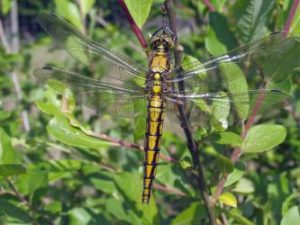
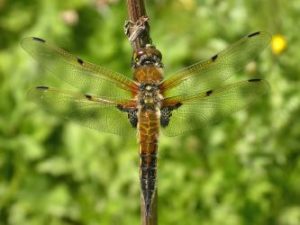
GLOW WORMS AND MOTHS – NORMANDY COMMON
Friday 29th June – Evening Walk: Bill Stanworth (FNW committee member) guided us through Normandy Common. A small group saw three glow worm’s (see below one carefully picked up in Bill’s hand) at about 11.00 pm wondering back to our cars! We were thrilled to see them and there location is now recorded. We also saw many moths some of which were caught in a safe trap and others by Bill and Samuel having fun with a net while walking! We heard a number of Pipestrelles with the bat detectors and a few saw a woodcock fly over on the edge of Dolleys Hill followed by a churr of a nightjar.
[Top photo of glow worm by David Evans under creative commons]
LAKESIDE NATURE RESERVE
Nine people joined Angela, Bill and Gill W on Saturday 9th June, a lovely sunny morning, for a walk round Lakeside Nature Reserve in neighbouring Ash Vale. The original plan of walking along the Basingstoke Canal was changed, as the recce proved disappointing from a wildlife point of view.
Opposite the car park is a traditional meadow, with over 20 species of meadow plants, including Grass Vetchling, Bacon and Eggs, Tufted Vetch, Clovers and White Campion. Flitting amongst the plants was a Common Blue Butterfly. Moving further into the reserve we noticed Yellow Flag and Marsh Bedstraw by the bridge. Water Plantain, a non-native Arrowhead, was growing in the one of the Stillwater Lakes. Here we saw out first damselfly, the Azure damselfly.
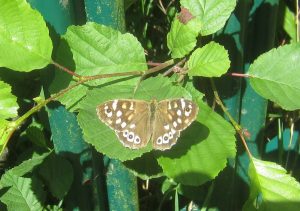
Beautiful damselflies and dragonflies were active on the ponds and the Blackwater River, including Banded Demoiselle, Black Tailed Skimmer, Common Blue Damselfly, Blue Tailed Damselfly, Emerald Dragonfly and the Hairy Dragonfly. Speckled Wood butterflies were active in the woods.
One pond had Water Violet.
In the reed beds Reed Warblers were singing, and we were lucky enough to catch a glimpse of one. Tiny toads, the size of a child’s fingernail, were making their way to the reeds. Coot and Mallard could be seen on the ponds and river, but the real “ah” moment was the sight of a moorhen with 8 small fluffy black chicks.
SOS – SAVE OUR SWIFTS – April 2018
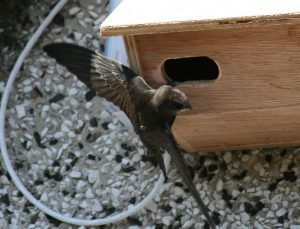
We all love the sound of swifts calling to each other as they perform their aerial acrobatics, but have you noticed how such sights and sounds are nowadays less common? Swifts are having problems, due to destruction of their habitats mainly through property renovation and modern architecture which excludes them from their traditional nesting sites in and around buildings. However, people are rallying to help stop the decline and, in April, FNW were lucky enough to have the Head of Swift Conservation, Dr Edward Mayer, come and tell us all about these amazing birds and what we can do to help them.
Some surprising facts and figures
Swifts have been around for a very long time – a fossil swift has been found from 49 million years ago! They spend all of their life on the wing and only ‘land’ when breeding. They are supremely economical fliers and can fly for 3 to 4 days without food even in tropical heat. They can fly right across the Sahara desert and have been known to get from Morocco to Cambridge in 2 days. A pair of swifts can eat 20,000 insects in a day including mosquitoes and aphids so provide an excellent biological control system for such pests. They are faithful to their partner for life, but only meet up when they come here to breed. Each pair has an average 1.5 chicks, and these take 42 days to fledge. The oldest recorded swift is 21!
Rallying round
Dr Mayer has been instrumental in the fight to save our swifts working with the public and an extraordinary number of commercial companies and organisations around the world. There are now 58 swift groups in the UK and across Europe. Surveys of swift numbers and nesting sites, publicity about the dangers swifts face and the creation of more nesting sites are the main focus of the many ongoing swift projects. Nesting sites for example using ‘swift bricks’ have been created in new and existing buildings – in churches, under bridges, in railway lift towers, on local landmarks and even in buildings put up for the Olympics! The birds prefer to nest socially so playing swift calls around new sites has been shown to attract the birds in to these.
In some towns, helping swifts has become a social event with people getting together to help protect their birds, designing swift-related products and organising street parties and other events to welcome the birds back from their winters in Africa.
What you can do
We were given a comprehensive list of things we could do to help:
* Support the laws protecting swifts.
* Count and monitor our local population and tell the British Trust for Ornithology (BTO) what we find.
* Make sure nest sites are not destroyed when renovating your house.
* Fit swift nest boxes to existing buildings.
* Look out for development, reroofing or demolition where swifts may be present and see if alternative sites can be provided nearby. Contact the building company or local Council – their service contractors have helped in some counties. It can provide good publicity for them and Dr Mayer said whole companies have become good supporters of his work.
* Join a Local Swift Network.
Dr Mayer and the Swift Conservation organisation are there to help us all help swifts. The organisation has an extremely good website at www.swift-conservation.org with masses of useful well illustrated information including details on: making your home a swifts’ home; what to do if you think swifts are threatened, including templates for letters to relevant authorities; local swift groups and events and practical advice on dealing with the birds themselves such as what to do if you find a grounded bird.
Photo Credit FS-Phil under creative commons
GARDENING FOR WILDLIFE – March 2018
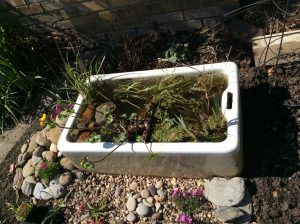
This month’s talk provided members and their family and friends with a fascinating insight into how even the smallest of gardens can provide a haven for wildlife. Our speaker Andrew Halstead was, until his retirement, the head entomologist at RHS Garden Wisley and so had a wealth of wildlife gardening experience to draw upon. He stressed that with the countryside under threat from agricultural practices and development, gardens are a crucial resource for wildlife.
Using his own 50x16ft garden as an example, he showed how it is possible to create different wildlife habitats within a limited space – and not just for birds, butterflies and mammals. There is a wealth of invertebrate wildlife that needs our support in order to attract our more obvious favourites – and as Andrew showed us, many of these smaller creatures are extremely attractive when seen close up.
Key to any wildlife garden is a pond, if possible with a damp border or boggy area incorporating native plants such as marsh marigold and lady’s smock. This will attract a wealth of aquatic insects and other invertebrates which will in turn offer a tempting source of food for frogs, toads and newts, who will then help provide free slug and snail control. Colourful damselflies and dragonflies will soon be hovering over the surface and laying their eggs in the water. Later when their nymphs are ready to transform into adults they will need some vertical plant stems to climb up (a flag iris or a sedge is ideal) so that they can perch and expand their new wings.
It is also important to provide a shallow area for birds to drink and bathe and an easy escape route for hedgehogs or other small animals that might fall in! Even if you do not have room for a full sized pond, you can create a mini version from a half barrel, washing up bowl or even an icecream container. Filled with rain water, with a bit of soil in the bottom and a few plants it is surprising what will come and visit.
Another ‘must’ for every garden is a compost heap which will support a huge range of invertebrate species including millions of springtails! But a word of caution, be careful when digging it out in case there are frogs, toads or, if you are lucky, a grass snake hiding in it.
Nest boxes and bat boxes are a welcome addition to any garden but there are lots of other habitats for food and shelter that you can create. A small tree, a native hedge (such as hawthorn) and ivy will provide perches and shelter for birds, and where these have flowers and fruit they will provide a food source as well. Ivy in particular is a real magnet for insects and birds.
Log piles, especially if left in a shady area where the wood will start to rot, will support a diverse range of fungi, beetles and other insects, as will an area of bare earth. This was one of the more surprising facts we learnt as was hearing that rot holes in trees often contain a rich and nutritious ‘soup’, a delight to many insects, particularly hoverflies!
Leaving some areas of long grass, perhaps in those difficult to cut places against a wall, and allowing some parts of the lawn to ‘go wild’ with white clover, daisies and birdsfoot trefoil, will also help – and save on lawn mowing!
In herbaceous borders try to plant flowers that have an ‘open’ appearance so that it is easy for insects to get at the nectar. A few teasels will attract goldfinches; sedums are a magnet for bees, butterflies and night flying moths; and giant thistles will attract carder bees who use the hairs from the plant to line the cells in their nests. And don’t be in a hurry to cut stems back in Winter, the dried leaves and stems provide shelter for insects which will in turn provide welcome winter supplies for birds such as robins, wrens and bluetits.
In the time available it was not possible to cover everything that can be done in a garden to help wildlife – or to report it here but hopefully we all went home feeling inspired to see what more we could do!
DRAGONFLIES – 14th February 2018
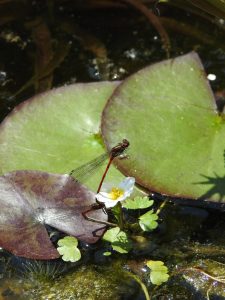
Simon Elson a member of the British Dragonfly Society and a Surrey Wildlife Trust warden for Nutfield Marsh wetlands gave us a fascinating talk on dragonflies and damselflies. Including a more detailed look at those species to be found in Surrey and their habitat needs.
RHODODENDRON CLEARING – 4th February 2018
Thanks to everyone who turned up to clear the invading rhododendron on Normandy Common . Much was achieved and it will really help improve the Common for wildlife. We hope there weren’t aching arms the next day!
ILLEGAL WILDLIFE TRADE – 10th January 2018

January 2018 saw us going global when WWF-UK’s Chief Adviser on Wildlife (and FNW committee member!) Heather Sohl, provided us with a thought provoking insight into the illegal international wildlife trade and the important work WWF is doing to combat this. Heather explained that elephants, rhinos and tigers are all at risk from poaching but there are many other species involved as well – and it is not just animals that suffer; the trade also impacts adversely on human communities in many countries. WWF is successfully tackling the issue in a number of ways, working with governments and other influential bodies to provide practical solutions to these difficult problems.

